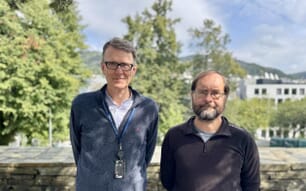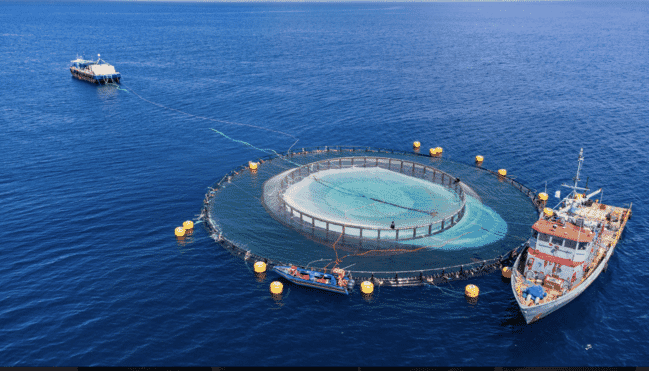
Salmon firms need to optimise everything from fish biology, site location, farming infrastructure, operational costs and licensing for offshore aquaculture to meet its potential © Forever Oceans
Despite the innovative production designs and growing industry hype around offshore aquaculture, the sector’s re-location to open waters probably won’t – in all likelihood – be a linear process. According to a recent case study in Reviews in Aquaculture, a lot of things need to “go right” for the industry’s offshore ambitions to become reality. Using the Atlantic salmon industry as an example, the researchers found that firms need to optimise everything from fish biology, site location, farming infrastructure, operational costs and licensing for offshore sites to meet their projected potential.
They also note that many of the production benefits highlighted by offshore advocates – namely reduced disease burdens and fewer algal blooms – are more complex than initially conveyed. Though moving salmon aquaculture offshore could be the industry’s next step forward, the researchers note that farming fish in open water will be more challenging than the current fjord-based model. Operational costs will be higher and production gear has to become more specialised and resilient to withstand offshore conditions. If the industry can meet these economic challenges, select appropriate sites and make sure they’re meeting the salmons’ biological needs, offshore aquaculture can cease being visionary and become viable.
The ethos behind offshore aquaculture
Though the buzz around offshore aquaculture has been ramping up, many of its predicted benefits are largely theoretical. According to the researchers, the purported advantages of offshore aquaculture have been touted without enough science-based evidence to back their claims. Because of this, the industry needs to review the data and look at current offshore projects to see if the hype is warranted.
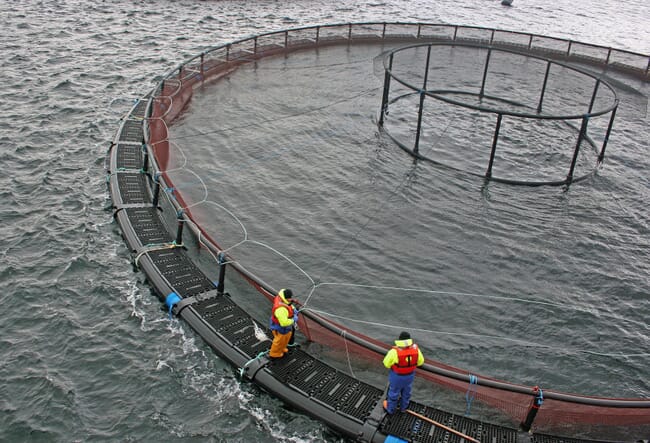
Many of the purported advantages of offshore aquaculture have been touted without enough science-based evidence to back the claims © Gael Force
Offshore farming is a potential game-changer because it presents a solution to recurring pain points in the salmon industry. The sector’s current production model is coming under pressure. Most Atlantic salmon firms produce fish sea cages in sheltered, fjordic lochs with restricted water exchange. However, countries that boast this geography – like Norway, Chile and Scotland – are facing farming challenges like sea lice and algal blooms. They’re also contending with stricter environmental regulations to crack down on nutrient pollution, pharmaceutical residues and fish escapes. The number of available nearshore locations is declining as well, so firms cannot build enough farm infrastructure to meet increasing demand for salmon.
These factors have led many salmon companies to make initial investments in offshore aquaculture. The offshore pitch usually points out that moving farm activities away from the coast allows producers to benefit from high-energy waves and currents. Fish that are reared in this environment can take advantage of improved water exchange rates and higher dissolved oxygen gradients than their nearshore counterparts. Wastes, treatment chemicals, sea lice and harmful algal blooms (HABs) are also more easily dispersed on offshore sites.
Offshore advocates also say that taking farms out of fjords can help the industry maintain high stocking densities without courting parasites or other pathogens. Sea lice infestations and disease outbreaks cost the industry billions each year and is a constant problem in fjordic enclosures. Parasite control becomes increasingly difficult when several farms occupy the same region or if different companies fail to coordinate anti-parasite treatments – the farms could re-infect each other as the parasites grow more resistant to medicinal treatments.
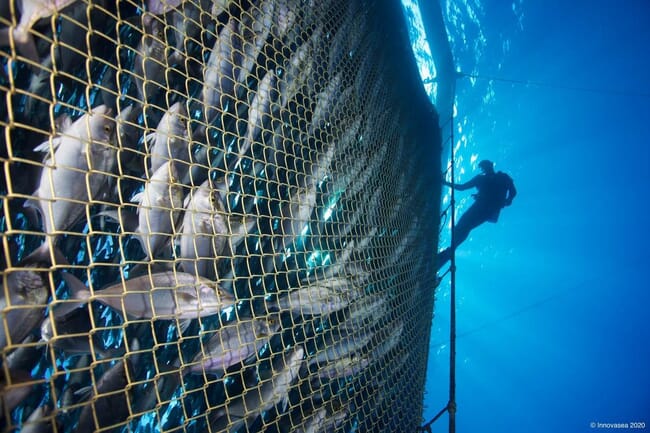
Offshore advocates also say that taking farms out of fjords can help the industry maintain high stocking densities without courting parasites or other pathogens © InnovaSea
Separating the sea cages across a larger offshore environment lets producers take advantage of improved water dispersion and may reduce parasite pressure. At the very least, it could prevent neighbouring production sites from infecting one another.
Evaluating the research that backs offshore aquaculture
The researchers look a close look at offshore trials and case studies to verify whether expectations matched the in-the-water reality. They looked at economic and engineering feasibility studies to identify potential pitfalls for new offshore farms. They also prioritised studies that focused on dispersive currents offshore, as advocates claim this impacts everything from sea lice levels, nutrient pollution and HABs. They also assessed studies that explored the health and welfare impacts offshore aquaculture could have on salmon.
Offshore – but where?
The importance of site selection was recurring theme in the literature and is probably the first hurdle to the sector’s offshore shift. The researchers noted that firms must identify sites that have ideal oceanographic conditions – waves, currents, dispersal patterns, benthic conditions and oxygen levels – for their target species to make offshore aquaculture viable. Data-driven models must map and predict incident wave conditions and the hydrodynamics must also be developed. If this is overlooked, producers will face heavy economic losses from poor fish health and damaged farm structures.
Moving salmon aquaculture offshore has logistical and economic implications. By nature, viable farm sites will be remote and subject to harsh environmental conditions. Offshore infrastructure will be battered by higher waves and more frequent storm events, meaning that farm equipment will experience greater wear and tear and be repaired – or even replaced – frequently. The researchers also note that transport costs will increase as the industry moves away from the fjords. This will translate into higher maintenance and costs, as well as operational limitations.
Offshore farm structures will have to change to accommodate the production reality – becoming larger, more robust and expensive. The industry is currently developing new fish cage designs. Closed-containment systems, submersible cages, vessel-like structures and repurposing oil rigs are being trialled to see what can withstand the harsh offshore waters.
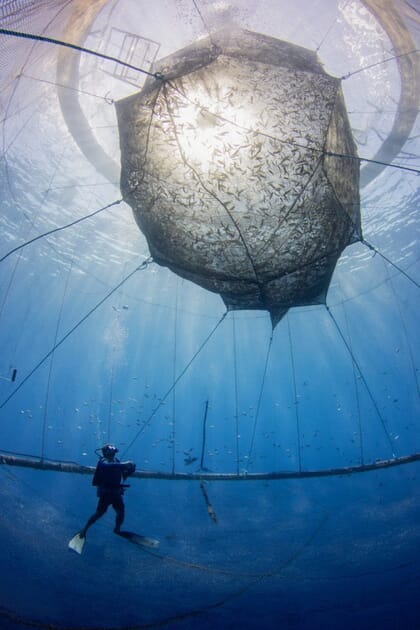
Moving offshore will make routine husbandry checks more challenging © Jeffrey Milisen
Permits, licensing fees and other governance frameworks are another costly bottleneck for the industry’s offshore push. The literature shows that many oversight bodies don’t have an agreed definition of “offshore aquaculture” – nor do they have regulatory systems to develop offshore technologies. Firms will need to have sufficient up-front capital to meet these development challenges before they can get in the water.
How will husbandry practices adapt to offshore production?
Salmon aquaculture already takes place in remote and rural areas and taking farm activities offshore will only make this more pronounced. As the industry moves production away from the coasts, transport costs for personnel will skyrocket. This has implications for on-farm husbandry checks and routine monitoring.
Daily farm activities like health and welfare checks, size grading, monitoring stocking densities, structural maintenance and cleaning will be more difficult and time consuming. Frequent storms are an additional consideration: bad weather could limit a firm’s ability to safely send technicians to farm sites and lead to husbandry lapses.
The only way to safely farm salmon offshore is to invest in aquatech that lets production become more self-sufficient. Adopting remote monitoring tech and precision farming would allow operators to automate and control important tasks from a base on land. The researchers also suggest investing in wireless tech and satellite uplinks, but that sector will need to develop products that can send and receive data during storm events. They also note that developing low-maintenance and reliable power supplies to keep offshore sites operational is a must when personnel are kept on land.
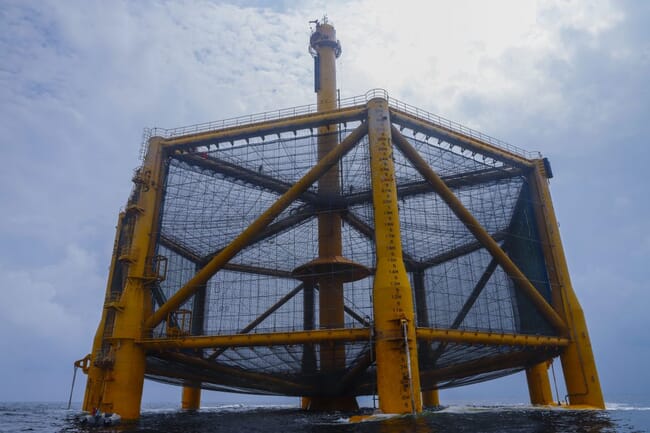
Moving offshore will likely require stronger farm infrastructure and aquatech solutions to accommodate the harsh and remote conditions © Rizhao Wazefeng Fishery
Does moving offshore reduce disease and sea lice burdens?
The theory that offshore sites have decreased disease and sea lice burdens is largely anecdotal. For diseases like amoebic gill disease (AGD), there isn’t any comprehensive evidence that moving offshore would address the issue. This makes predicting the potential infection path and impact of salmon diseases at offshore sites complicated. On the one hand, increased oxygen and water exchange offshore may keep parasite levels low, or conversely, the offshore environment may make it more difficult for infected fish to recover.
For sea lice, the evidence is similarly ambiguous. The researchers couldn’t find much to support claims of lower lice counts offshore in the published literature – the sole study that compares nearshore and offshore sea lice burdens and health performance is from 10 years ago. That publication compared the production of Southern bluefin tuna (Thunnus maccoyii) at two farm sites in Australia. The key findings from that study showed that tuna raised 25 nautical miles from the coast had better overall growth and health performance than those raised 16 nautical miles from the coast. The study also concluded that sea lice prevalence was significantly lower offshore.
There are indirect reasons to believe that offshore aquaculture could keep sea lice at bay. The dispersive environments and greater distance from the coast will likely reduce lice retention and exchanges between production sites. Offshore environments are also marked by higher surface salinities, current speeds and varying water temperatures that make it difficult for lice to attach to farmed salmon.
Though the researchers concede that this finding is good news, it certainly doesn’t mean that there’s zero risk of sea lice infestation. They warn that sea lice can still reach offshore sites and cause devastating infestations. Some natural de-lousing strategies like cleanerfish aren’t effective offshore either.
An additional concern is that moving farms to remote offshore locations makes it more challenging to monitor fish for signs of lice infestations or other diseases. This gap in monitoring could makes it more difficult for producers control outbreaks if they emerge.
Does offshore farming decrease the risk of HABs?
Harmful algal blooms are putting increasing pressure on the salmon industry’s production status quo and – in some cases – have scuppered potential aquaculture developments. HABs tend to occur from nutrient pollution from farm activities and can be made more severe by the restricted water exchange in fjordic environments.
The researchers found that the dispersive environment in offshore locations have the potential to scatter farm wastes and chemical treatments away from fish pens. Though at first glace this dispersal could benefit benthic communities and limit the formation of HABs, the impact of the dissolved wastes is more complex. The impact could either be positive or negative depending on the oceanographic conditions of the offshore site.
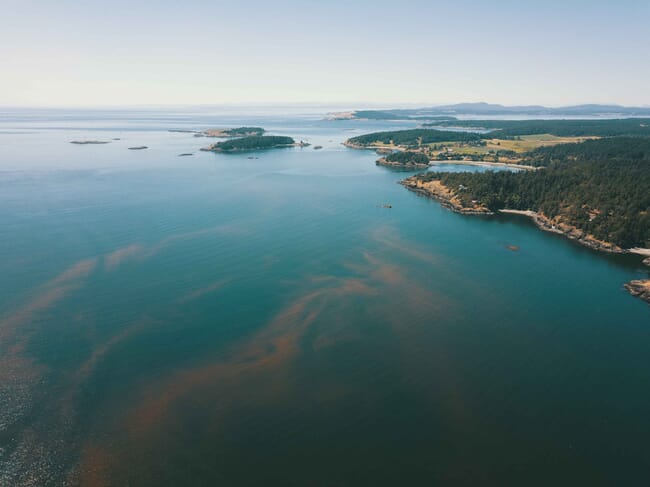
Many HABs develop and bloom extensively offshore before moving towards the coast
The researchers note that while HABs are devastating in nearshore environments, many of these harmful organisms develop and bloom extensively offshore before moving towards the coast. It’s possible that an offshore site could be caught in the path of a growing bloom event. Given the difficulties of monitoring offshore aquaculture sites and HABs in general, they still pose a risk to offshore farm operators. The researchers suggest developing a combination of satellite and in-situ monitoring along with data modelling to minimise the risk of HABs.
Are there any other salmon welfare impacts?
The researchers identified some health benefits to moving salmon farms offshore. Studies showed that raising salmon in moderate water velocities (0.36 – 0.63 body lengths per second) can be beneficial for growth and muscle fibre size – the increased speeds stimulate feed intake and energy conversion efficiency. The researchers also noted that salmon raised in these environments were more robust than salmon reared in coastal net pens.
Strong offshore currents and frequent storms have implications for the fishes’ natural behaviour though. Moving farms away from the coasts means farmed salmon must withstand a myriad of unpredictable events during the production cycle. The remote nature of offshore farming also means that fish may experience husbandry lapses or food deprivation if there is bad weather.
The researchers warn that the nominally better operational welfare indicator (OWI) of offshore salmon farms may be a statistical fluke. The harsh offshore environment means that weaker animals will die more easily. This partially explains why there are fewer fish with deformities, cataracts and injuries observed in offshore farms. Salmon with these conditions are typically recorded as mortalities. Had the fish been raised in nearshore sites, they probably would have included in a low OWI cohort.
Strong currents have other implications for salmon welfare. The offshore environment tends to dictate the swimming pattern and speed for farmed salmon instead of letting the fish self-regulate according to their own endurance. The researchers noted that high current speeds – where the fish had to sustain 2.5 body lengths per second – led to incidences of inflammation and skin and pelvic lesions. Though Atlantic salmon are migratory and can swim at a fast speed, forced swimming for long periods may exceed their physical capabilities. It also means that the fish will use more energy trying to maintain homeostasis instead of growing to slaughter weight.
Because of this, the researchers suggest opting for land-based production for juvenile fish and moving larger post-smolts (measuring 63.5 cm or 3.4 kg) into offshore cages. This deviates from the current farm model that transfers smolts into seawater at around 300 g. They also suggest acclimating the fish in seawater at low energy sites and using current speed reducing technologies like skirts or double nets to avoid fish mortalities.
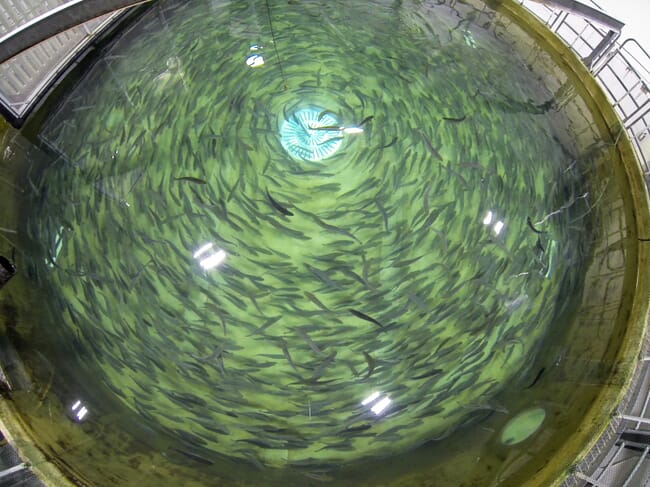
Salmon farmers should raise juveniles on land and acclimate them near the coast before deploying them offshore © Freshwater Institute
One final welfare consideration lies in dissolved oxygen levels in large offshore cages. Multiple studies found that oxygen levels decrease as offshore cage sizes increase. Oxygen concentrations are also negatively impacted when lice shielding skirts are deployed. The researchers said that the industry needs to address this challenge and design a cage that can accommodate the 1,000 to 10,000-tonne biomass goals without creating a de-oxygenated dead zone.
Moving out to sea
According to industry analysts, offshore aquaculture is one of the few ways to keep the sector on a growth trajectory. New coastal aquaculture developments are few and far between – salmon aquaculture’s journey offshore may come because there isn’t enough space in the fjords.
Despite this prevailing trend and consensus, the industry still needs to conduct significant groundwork before offshore farming can overcome its initial challenges. Everything from licensing and permitting, farm infrastructure and precision monitoring technologies need to be developed to accommodate the requirements of offshore production. The researchers also note that offshore operations will be much more capital and resource intensive than their nearshore counterparts. Though there are notable benefits to moving salmon aquaculture into the open sea, the industry still needs to clear its initial hurdles before offshore aquaculture can meet its potential.


